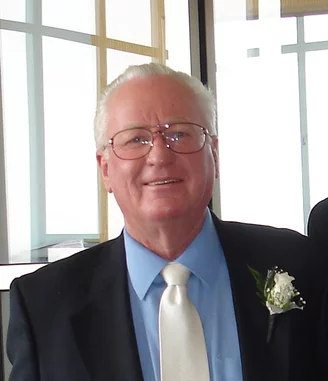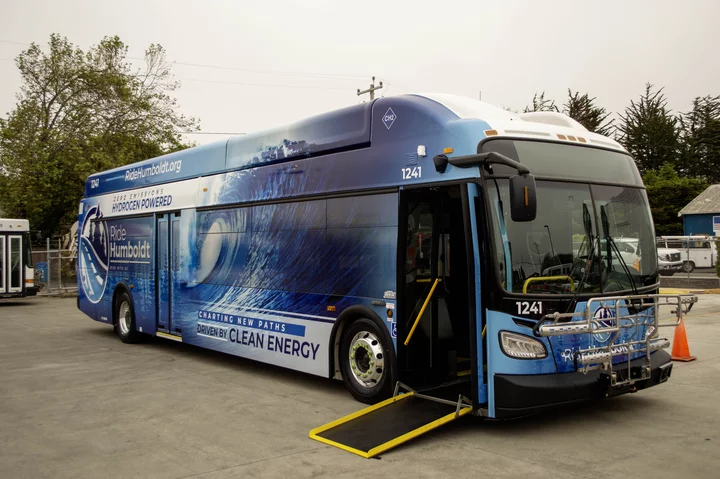Annie and Mary Trail Update: First Chunk to Dorms Almost Completely Done, Total Completion by End of Next Year Likely
Dezmond Remington / Friday, Nov. 21 @ 1:42 p.m. / Trails
A construction worker smoothing out asphalt next to the trailhead at the skate park. By Dezmond Remington.
The long-awaited opening of the Annie and Mary Trail isn’t exactly tomorrow — but it is coming soon.
The quarter-mile segment from the Arcata Skate Park on Sunset Avenue down to the Hinarr Hu Moulik dorms was paved this week after a few weeks of clearing foliage from the old railroad bed. It’s not officially open yet (the concrete was still wet this morning where the trail connected to the sidewalk), but will likely be 100% ready for use by the end of November when some crosswalks are added.
Beyond that, Granite Construction crews have started ripping up brush and laying the foundation for more trail on West End Road past the Arcata Ridge trailhead. When it’s complete, it’ll run all the way from Arcata out to the Mad River.
A map of the project. Photo courtesy of the City of Arcata.
Work will continue on the last 3.5 miles of trail through the winter and into 2026 and may be finished late in the summer. The section to the Arcata Ridge trailhead might be done by the end of 2025.
Emily Sinkhorn, the city’s Director of Environmental Services, told the Outpost that she was grateful for the years of planning and dreaming that advocates put into the project, as well as to Cal Poly Humboldt and the Yurok Indian Housing Authority for helping fund it. She’s happy to see skateboarders roll up to the park and students walking to class on it.
“If you build multi-use trails, especially ones that go between destinations and where people live; people are going to use it,” said Sinkhorn. “It’s like, ‘Aaah, why did it take this long?’ But it’s really exciting to see people use it. It’s going to make a big difference for safety and for the feeling of safety.”
BOOKED
Yesterday: 3 felonies, 4 misdemeanors, 0 infractions
JUDGED
Humboldt County Superior Court Calendar: Today
CHP REPORTS
No current incidents
ELSEWHERE
RHBB: Vehicle Hits Deer on Highway 101 Near Redcrest
RHBB: Solo Vehicle Crash Overturns Subaru on Highway 101 Near Miranda
Governor’s Office: Governor Newsom prepositions emergency resources in Southern California ahead of New Year’s Storm
Cal Poly Humboldt Buys 191 Acres of Former Sun Valley Floral Farms Ag Land for $5M
LoCO Staff / Friday, Nov. 21 @ 1:35 p.m. / Cal Poly Humboldt
The newly purchased parcels are outlined in yellow. | Map via Cal Poly Humboldt.
###
PREVIOUSLY
- Sun Valley Floral Farms Issues Layoff Notices to Entire Workforce in Arcata and Oxnard
- In Letter to Industry Colleagues, Sun Valley Floral Farms CEO Explains the Factors That Led to the Company’s Demise
- PLANT DISMANTLED: They’ll Be Auctioning Off All Sun Valley Floral Farms’ Infrastructure Next Month
- TOP 25 STORIES of 2024: Earthquakes, Foul Weather, Campus Occupations … and Leonardo DiCaprio!
- Former Sun Valley Property Fails to Sell at Auction This Morning
- OBITUARY: Michael Joseph Mangiantini, 1952-2025
- Foster Clean Power: New Solar Energy and Battery Storage Project Launched Near Arcata
- Hey, Are There Any Land Trusts or Something Along Those Lines That Would Want to Own the Old Sun Valley Floral Farms Land? Anyone? Because the Seller’s Agent Would Really Like to Talk With You
###
Press release from Cal Poly Humboldt:
Cal Poly Humboldt announced today the acquisition of 191 acres of agricultural and industrial property on Foster Avenue in Arcata. The property, which includes a 418,320-square-foot industrial building, represents an investment in the University’s long-term growth as California’s newest polytechnic institution.
The property, part of the former Sun Valley Farms site, was purchased by the Cal Poly Humboldt Foundation and leased to the University. There are no current plans to develop the 191-acre property.
“This acquisition provides Cal Poly Humboldt with the space and flexibility we need to grow responsibly while stewarding important resources in our community,” said Steve Karp, Cal Poly Humboldt’s acting vice president for Advancement and executive director for the Cal Poly Humboldt Foundation. “While we have no immediate development plans for this property, securing land for future generations of students is essential to fulfilling our polytechnic vision.”
The $5.05 million property currently has existing lease agreements with established agricultural tenants, including Driscoll’s Berries and Sierra Madre Mushrooms. The University will continue with the leases, preserving agricultural jobs and operations in Arcata.
Key features of the property include:
- 191 acres of land with flexible Agriculture, Commercial, and Industrial zoning
- 418,320-square-foot warehouse building
- Ample water resources with 400 gallons-per-minute capacity from ground wells
- 600,000-gallon fire mitigation tank
- Established agricultural operations
- Proximity to Highway 101, Arcata-Eureka Airport, and Port of Humboldt Bay
“Cal Poly Humboldt remains committed to being a thoughtful neighbor and responsible steward of land in Humboldt County,” said Michael Fisher, acting vice president for Administrative Affairs and Chief Financial Officer. “This property allows us to support existing agricultural operations while providing options for future growth as our polytechnic programs evolve.”
The acquisition expands upon two contiguous Foster Avenue properties. The first is the University’s 16-acre parcel purchased in 2022, planned as a transportation and mobility hub with shuttle service to support nearby student housing. Based on community input, the University is actively re-evaluating its plans. Another adjoining 26 acres purchased by the Foundation in 2024, was leased to the University and is partially being developed as an instructional farm.
Cal Poly Humboldt will work closely with the City of Arcata, neighboring property owners, and community stakeholders on any future uses of the newest Foster Avenue property, ensuring compliance with the California Environmental Quality Act (CEQA) and local land-use policies.
The Foster Avenue properties complement Cal Poly Humboldt’s polytechnic transformation. With support from the state’s $458 million investment, the University built the Hinarr Hu Moulik student housing complex (964 beds), launched numerous new academic programs, and made significant infrastructure improvements.
Democrat Eric Swalwell Joins Crowded California Governor’s Race to Succeed Gavin Newsom
Maya C. Miller / Friday, Nov. 21 @ 11:01 a.m. / Sacramento
Swalwell at the 2019 state Democratic convention. Photo: Gage Skidmore from Peoria, AZ, United States of America, CC BY-SA 2.0, via Wikimedia Commons
###
This story was originally published by CalMatters. Sign up for their newsletters.
###
Rep. Eric Swalwell, a former Democratic presidential candidate who helped lead the second impeachment of President Donald Trump, has officially entered the fray to succeed California Gov. Gavin Newsom in next year’s gubernatorial race.
His core message? “Prices are too high and people are scared.”
Swalwell, 45, a prominent Trump antagonist on social media and a cable news darling who ran a short-lived bid for the White House in 2019, made the announcement Thursday night at the tail end of a nearly 10-minute interview with late-night host Jimmy Kimmel.
After joking that California was “the greatest country in the world,” to laughs from the Los Angeles studio audience, Swalwell grew serious and decried how Californians have been disproportionately targeted by a second Trump administration, whether through vengeful immigration raids or the cancellation of critical cancer and health research.
“This great state needs a fighter and a protector,” Swalwell said.
In a video posted to his campaign website, which went live shortly before his appearance on “Jimmy Kimmel Live!” aired, Swalwell says “no one will keep California safer” than he will. He name-drops Speaker Emerita Nancy Pelosi — the San Francisco titan of Democratic politics who recently announced her own retirement — and points to her decisions to appoint him to the House Intelligence Committee and as one of four Trump impeachment managers following the Jan. 6, 2021 attack on the U.S. Capitol.
Swallwell’s announcement comes a day after billionaire liberal activist Tom Steyer announced he is running to replace Newsom when he terms out in 2027. At least six other high-profile Democrats are also running, including former Rep. Katie Porter, former Health and Human Services Secretary Xavier Becerra and former Los Angeles Mayor Antonio Villaraigosa. Prominent Republican challengers include Riverside County Sheriff Chad Bianco and former Fox News contributor Steve Hilton.
The challenge for the seven-term congressman, who said recently he was among the latest of Trump’s political enemies to be targeted for investigation by the Justice Department, will be proving he can govern for Californians at home in addition to sparring with Republicans on the national stage.
“We can say that we’re the fourth largest economy in the world — and we are, and I love to brag about that — but what does that mean if you can’t afford to live here?” Swalwell told Kimmel on Thursday.
On that front, Swalwell offers no concrete policy promises in his initial launch, but instead cites his experience as a planning commissioner and city councilmember for his hometown of Dublin, the Bay Area suburb nestled east of Hayward and west of Livermore. He represents the same region in Congress.
“I’ve worked as a planning commissioner and city councilman in a place of low income and low expectations and helped lead my hometown to become one of California’s most prosperous cities,” Swalwell’s campaign site says. “I’ll take that approach to the whole state.”
Newsom Closed 4 Prisons and Trimmed Payroll. Corrections Spending Is Still Over Budget
Cayla Mihalovich / Friday, Nov. 21 @ 7 a.m. / Sacramento
An inmate jumps rope in the courtyard at San Quentin State Prison on July 26, 2023. Photo by Semantha Norris, CalMatters
###
This story was originally published by CalMatters. Sign up for their newsletters.
###
Some of the red ink in California’s budget deficit is coming from unplanned spending in state prisons, according to a new report from the Legislative Analyst’s Office.
The California Department of Corrections and Rehabilitation is on track to exceed its budget by roughly $850 million over three years despite recent cuts that include four prison closures and some labor concessions that trimmed payroll expenses. The state budget included $17.5 billion for prisons this year.
The office attributed the corrections department’s shortfall to both preexisting and ongoing imbalances in its budget. The analyst’s annual fiscal outlook projected a nearly $18 billion deficit for the coming year, which follows spending cuts in the current budget.
The corrections department last year ran out of money to pay its bills. In May, it received a one-time allocation of $357 million from the general fund to cover needs including workers’ compensation, food for incarcerated people and overtime.
Democratic Sen. Scott Wiener of San Francisco in a June 17 letter to the Department of Finance said he was “shocked and disappointed that (the corrections department) overspent its budget by such a significant amount” while the state faced a $12 billion general fund shortfall that resulted in cuts to key health care and social service programs.
“These were dollars that could have been used to provide basic services to some of our most underserved communities,” wrote Wiener. “While this year’s budget included measures requiring departments to ‘tighten their belts’ and reduce state operating expenses by up to 7.95%, (the corrections department) did the opposite, and overspent by nearly three percent.”
Without having any new dedicated funding to align its actual costs with its budget, Wiener warned, deficits “will likely persist” and put additional pressure on the general fund in years to come.
That’s despite Gov. Gavin Newsom’s attempts to save the state money through prison closures. Newsom in May moved to close the state prison in Norco in Riverside County next year, the fifth prison closure under his tenure.
Newsom’s administration estimates it saves about $150 million a year for each prison closure, which lawmakers and advocates regard as the only way to significantly bring down corrections spending. A spokesperson for Newsom’s Finance Department declined to comment on the analyst’s projection. Newsom will release his next budget proposal in January.
“We are allowing wasteful prison spending to continue while Californians are being told to tighten their belts and brace for deep federal cuts to core programs,” said Brian Kaneda, deputy director for the statewide coalition Californians United for a Responsible Budget in a statement to CalMatters. “We are spending millions on prisons that could be safely closed. That is government waste, not public safety.”
OBITUARY: Robert Donovan Dunlap, 1944-2025
LoCO Staff / Friday, Nov. 21 @ 6:56 a.m. / Obits
Robert Donovan Dunlap passed peacefully at the age of 81 on Thursday evening, October 16, 2025 in Eureka. He fondly was known as “Bob” and will be remembered for his kind heart, funny sense of humor and being a great storyteller.
His childhood was spent in Cambria and Chino, California. He later attended Villanova Prep in Ojai, where he was a standout baseball & basketball athlete and would receive a sports scholarship to the University of San Diego. He graduated from USD in 1966 and would begin his career as a school teacher back in his roots of Chino.
While he thoroughly enjoyed being an educator, he would find his professional success as a chief executive officer of several county fairs throughout the state of California in San Bernardino County, Kern County Trinity County and Solano County. His passion for these communities would shine through with his ideas to showcase projects and exhibits from agriculture to entertainment to local crafts.
He was the ultimate host with his love for food and spirits to share with all that came in contact with him at his elaborate BBQ parties to break bread and toast a beverage with his friends, employees, and family. Bob also enjoyed making people laugh with his incredible repertoire of jokes that he could deliver with the perfect cadence, accent, timing and punchline. We were all better for knowing Bob and all he had to give to show in how much he loved and cared for the many people that had the pleasure of calling him friend.
He is survived by his children Brian Dunlap, Julie Fernstrom, Timothy Dunlap, Erin Dunlap, Tony Dunlap and eight grandchildren.
###
The obituary above was submitted on behalf of Robert Dunlap’s loved ones. The Lost Coast Outpost runs obituaries of Humboldt County residents at no charge. See guidelines here.
(VIDEO) Kelly Clarkson Honors Yurok Tribal Members in Her ‘RAD HUMAN’ Segment
Andrew Goff / Thursday, Nov. 20 @ 4:44 p.m. / Community
As you know, the Kelly Clarkson Show is “the uplifting daytime destination for humor and connection,” a boast which was on full display today when Kelly had on a couple of our neighbors on to share their story.
During today’s “RAD HUMAN” portion of the show, Clarkson interviewed Amy Bowers Cordalis, a Yurok attorney who chronicled her tribe’s generational fight to remove dams on the Klamath River. Later in the segment, Cordalis was joined by her niece, Keeya, one of the young people who, earlier this year, became among the first to kayak the river’s full length in more than a century.
Tune in above!
We Want More Bus Routes, Say Arcata Residents at Council Meeting
Dezmond Remington / Thursday, Nov. 20 @ 4:14 p.m. / Government
An HTA bus. Photo by Dezmond Remington.
A short and unsubstantial Arcata City Council meeting last night was highlighted by a public hearing where commenters shared their opinions on public transportation with a focus on their “unmet needs.” On the whole, much of the feedback was positive — but the Humboldt Transit Authority’s inability to run buses on Sundays and late at night got some flak.
The comments will be forwarded to the Humboldt County Association of Governments. Other jurisdictions have done the same; both the Humboldt County Board of Supervisors and the Eureka City Council heard from residents this past week.
Both speakers and councilmembers talked about the difficulty people without cars have getting around Humboldt County; councilmember Kimberley White even mentioned she had to hitch rides after meetings back to Valley West when her car needed repairing recently. The lack of public transport to Bayside and south G Street was also mentioned.
Councilmember Stacy Atkins-Salazar said there was a chance the requests for late night and Sunday routes may never be realized, despite their frequency.
“Obviously, it’s important to hear all of the unmet needs,” she said. “But I think when they get evaluated, they go through a process of what is reasonable to meet, which is a whole metric. So just because we might want Sunday service or Bayside (which lots of people do), if the metrics don’t show that it’s reasonable to meet for funding, then it doesn’t get met. Which is why sometimes we hear the same requests year after year.”
It wasn’t all bad news; Mayor Alex Stillman said that over 1,000 Cal Poly Humboldt students were riding the bus to and fro the new Hinarr Hu Moulik dorms daily, and White said she was excited to be able to take a cheap public bus all the way to Willow Creek to see family during the holidays. The route to Ukiah got a few shoutouts as well from the councilmembers, as did HTA’s affordability, dependability, and speed.
“You have to have numbers to run all night. We’re not an urban area like San Francisco,” Stillman said. “…We’re not there yet. Our population base is still 134,000 people for the entire county. It’s going to take a while for this to come.”
Other tidbits: Hyland Fence, Forest Update, End of Stillman’s Tenure
City Manager Merritt Perry said during his report that he’d reached out to the owners of a property on Hyland Street in Bayside whose recently installed fence was blocking pedestrian access to Golf Course Road (a few Bayside residents complained about the fence at the last city council meeting. The old shortcut shaved off about 200 yards). However, both the fence and the path are on private property, and Perry said they didn’t seem too interested in removing it. No action for future meetings was planned.
Michael Furniss, the chair of the Forestry Management Committee, updated the council on the various going-ons in city-owned forests, complete with trail cam footage of cougars and owls and other creatures. Surprise: there are a lot of ‘em out there!
Last night’s meeting was the last city council meeting 86-year-old Alex Stillman will preside over as mayor. A special meeting to elect a new mayor and vice mayor will be held Dec. 11.










